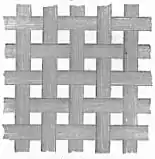Sieve
A sieve, fine mesh strainer, or sift, is a device for separating wanted elements from unwanted material or for controlling the particle size distribution of a sample, using a screen such as a woven mesh or net or perforated sheet material.[1] The word sift derives from sieve.


In cooking, a sifter is used to separate and break up clumps in dry ingredients such as flour, as well as to aerate and combine them. A strainer (see Colander), meanwhile, is a form of sieve used to separate suspended solids from a liquid by filtration.
Industrial strainer
Some industrial strainers available are simplex basket strainers, duplex basket strainers, T-strainers and Y-strainers. Simple basket strainers are used to protect valuable or sensitive equipment in systems that are meant to be shut down temporarily. Some commonly used strainers are bell mouth strainers, foot valve strainers,[2] basket strainers. Most processing industries (mainly pharmaceutical, coatings and liquid food industries) will opt for a self-cleaning strainer instead of a basket strainer or a simplex strainer due to limitations of simple filtration systems. The self-cleaning strainers or filters are more efficient and provide an automatic filtration solution.[3]
Sieving
Sieving is a simple technique for separating particles of different sizes. A sieve such as used for sifting flour has very small holes. Coarse particles are separated or broken up by grinding against one another and the screen openings. Depending upon the types of particles to be separated, sieves with different types of holes are used. Sieves are also used to separate stones from sand. Sieving plays an important role in food industries where sieves (often vibrating) are used to prevent the contamination of the product by foreign bodies. The design of the industrial sieve is of primary importance here.[4]
Triage sieving refers to grouping people according to their severity of injury.
Wooden sieves

The mesh in a wooden sieve might be made from wood or wicker. Use of wood to avoid contamination is important when the sieve is used for sampling.[5] Henry Stephens, in his Book of the Farm, advised that the withes of a wooden riddle or sieve be made from fir or willow with American elm being best. The rims would be made of fir, oak or, especially, beech.[6]
US standard test sieve series
A sieve analysis (or gradation test) is a practice or procedure used (commonly used in civil engineering or sedimentology) to assess the particle size distribution (also called gradation) of a granular material. Sieve sizes used in combinations of four to eight sieves.
| Tyler | Sieve | Sieve opening | |
|---|---|---|---|
| (in) | (mm) | ||
| — | 5 inch | 5.0 | 125 |
| — | 4.24 inch | 4.24 | 106 |
| — | 4 inch | 4.0 | 100 |
| — | 3+1⁄2 inch | 3.5 | 90 |
| 2.97 inch | 3.0 inch | 3.0 | 75 |
| — | 2+1⁄2 inch | 2.5 | 63 |
| — | 2.12 inch | 2.12 | 53 |
| 2.10 inch | 2 inch | 2.00 | 50 |
| — | 1+3⁄4 inch | 1.75 | 45 |
| 1.48 inch | 1+1⁄2 inch | 1.50 | 37.5 |
| — | 1+1⁄4 inch | 1.25 | 31.5 |
| 1.05 inch | 1.06 inch | 1.06 | 26.5 |
| — | 1 inch | 1.00 | 25.0 |
| 0.883 inch | 7⁄8 inch | 0.875 | 22.4 |
| 0.742 inch | 3⁄4 inch | 0.750 | 19.0 |
| 0.624 inch | 5⁄8 inch | 0.625 | 16.0 |
| 0.525 inch | 0.530 inch | 0.530 | 13.2 |
| — | 1/2 inch | 0.500 | 12.5 |
| 0.441 inch | 7⁄16 inch | 0.438 | 11.2 |
| 0.371 inch | 3⁄8 inch | 0.375 | 9.5 |
Other types
- Chinois, or conical sieve used as a strainer, also sometimes used like a food mill
- Cocktail strainer, a bar accessory
- Colander, a (typically) bowl-shaped sieve used as a strainer in cooking
- Flour sifter or bolter, used in flour production and baking
- Graduated sieves, used to separate varying small sizes of material, often soil, rock or minerals
- Mesh strainer, or just "strainer", usually consisting of a fine metal mesh screen on a metal frame
- Laundry strainer, to drain boiling water from laundry removed from a Wash copper, usually with a wooden frame to facilitate manual handling with hot contents
- Pickle lifter – Device for lifting pickled goods from a container
- Riddle, used for soil
- Spider, used in Chinese cooking
- Tamis, also known as a drum sieve
- Tea strainer, specifically intended for use when making tea
- Zaru, or bamboo sieve, used in Japanese cooking
- Other uses
- "Sieve" is a common term used in trash-talk referring to a goaltender in ice hockey who lets in too many goals[8]
- "Leaks like a sieve" is an English language idiom to describe a container that has multiple leaks, or, by allegory, an organization whose confidential information is routinely disclosed to the public.
See also
References
- Ruhlman, Michael; Bourdain, Anthony (2007). The Elements of Cooking: Translating the Chef's Craft for Every Kitchen. Simon and Schuster. p. 216. ISBN 978-1-4391-7252-0.
- "Industrial Strainers - Liquid Basket Strainer - Eaton Strainers". industrialstrainer.com.
- Finex, Russell. "Replacing Bag Filters with Self Cleaning Filters - Russell Finex". www.russellfinex.com.
- "Powder Checking - Vibrating sieve - Vibrating sifters - PowderProcess.net". www.powderprocess.net.
- B. De Vivo; Harvey Belkin; Annamaria Lima (2008). Environmental Geochemistry: Site Characterization, Data Analysis and Case Histories: Site Characterization, Data Analysis and Case Histories. Elsevier. p. 84. ISBN 978-0-08-055895-0.
- Henry Stephens (1852). The Book of the Farm. Vol. 1. W. Blackwood. pp. 414–416.
- Glover, Thomas J. (1992). Pocket Ref (Second ed.). Littleton, Col.: Sequoia Publishing. ISBN 9780962235900. OCLC 34710295.
- "Sieve Chant". uwbadgers.com. Retrieved 9 September 2020.